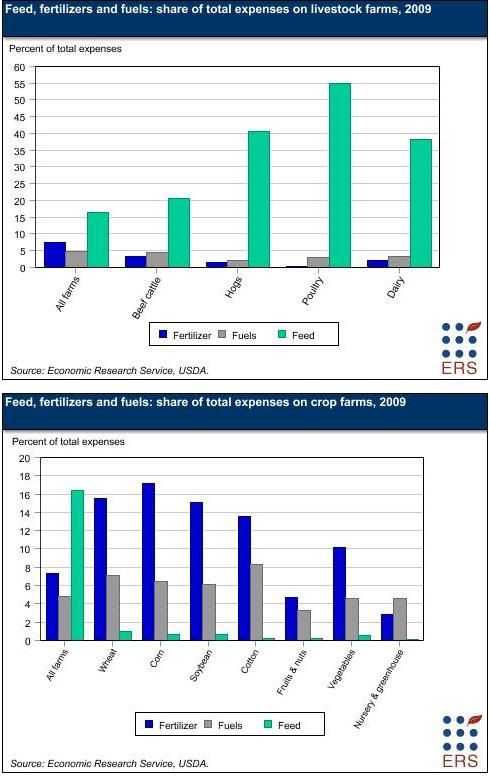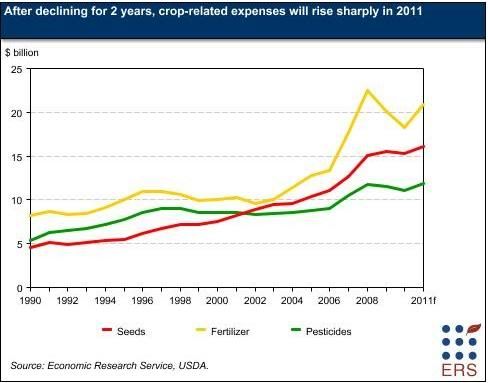This post contains information about the rising costs of inputs for industrial agriculture, namely fertilizer, fuels, and pesticides. There is a goal growing in momentum from both agribusiness and producers to increase production while improving sustainability and lowering input costs. Luckily, methods which lower input costs generally improve sustainability. The following graphs and statistics are taken from a usda report from earlier this year. As input costs increase, farmers take greater risks and rely upon high commodity prices, for which there is no guarantee. ---KM



(usda FEB 2011 report)

- After falling $12.0 (4.1 percent) billion in 2009 and rebounding a relatively modest $6.5 billion (2.3 percent) in 2010, total production expenses are set to jump $20.2 billion (7.0 percent) in 2011 to a nominal record $307.5 billion.
- This is the first time that expenses will have exceeded $300 billion.
- Despite crossing this threshold, 2011 inflation-adjusted expenses still remain below the levels reached in 1979 and 1980.

- In 2011, feed expenses are forecast to again make a sizeable jump, going up $4.6 billion (10.2 percent).
- Crop-related expenses grew 77 percent between 2002 and 2008, with 48 percent of the rise occurring in 2007-08.
- During 2009-10, the climb stalled and crop-related expenses fell nearly 10 percent.
- The primary reason for this pattern was movements in fertilizer expenses, which jumped 134 percent during 2002-08 and then dropped 19 percent in 2009-10.
- Crop-related expenses are expected to rise 9.5 percent in 2011, again due largely to an expected increase of more than 14 percent in fertilizer expenses.
- Use of pesticides and more expensive seeds with increasingly complex genetic traits has increased, and this demand has been a factor in rising prices over this period.

- Between 1999 and 2008, prices paid for seeds rose 146 percent, with 64 percent of that rise occurring during 2006-09, and seed expenses have increased $8.3 billion (115 percent).
- Fertilizer prices rose steadily between 2002 and 2008, with the annual average prices paid for fertilizers climbing 264 percent.
- Pesticide expenses rose steadily from 2002 to 2008. In 2007 and 2008 alone, they rose $2.7 billion (30.0 percent).
- As with fertilizer, prices paid for fuel rose dramatically between 2002 and 2008. During this period, annual average prices paid for fuel jumped 207 percent, registering 6 straight double-digit percentage increases, and fuel and oil expenses shot up $9.6 billion (146 percent).
- The 3 manufactured inputs—fertilizer, pesticides, and fuels and oils—together climbed $26.0 billion (106 percent) in the 2002-08 period.
(usda FEB 2011 report)